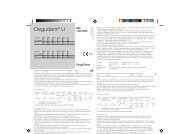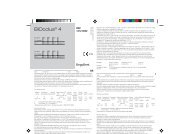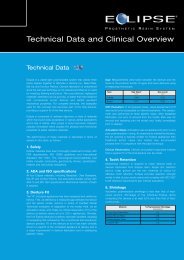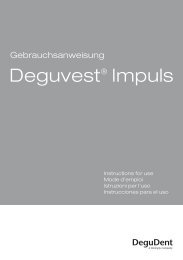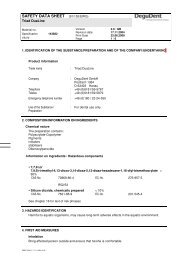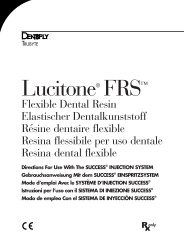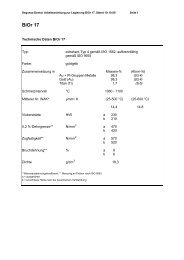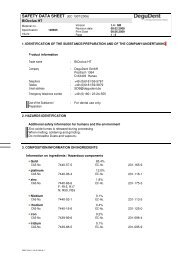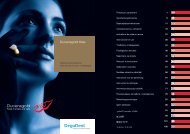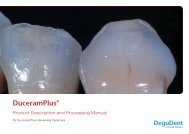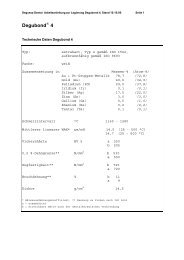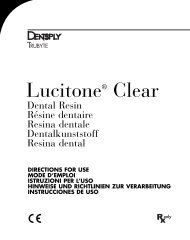Create successful ePaper yourself
Turn your PDF publications into a flip-book with our unique Google optimized e-Paper software.
Shade conversion chart/Instructions for use<br />
Table 1: Colour conversion chart, <strong>Cercon</strong> <strong>ceram</strong> kiss<br />
Shade A1 A2 A3 A3,5 A4 B1 B2 B3 B4 C1 C2 C3 C4 D2 D3 D4<br />
Standard layering<br />
Opaque x x x x x x x x x x x x x x x x<br />
Dentine x x x x x x x x x x x x x x x x<br />
Incisal 1 2 3 3 5 1 1 4 6 1 5 5 6 2 4 4<br />
Individual layering<br />
Opaque x x x x x x x x x x x x x x x x<br />
Opaque Orange For characterizing occlusal, cervical and palatal regions.<br />
Opaque Bleach For extremely bright/bleached teeth. Normally used in connection with bleach dentines only.<br />
Opaque Gum For gingival aspects.<br />
Shoulder SM/F SM 1 2 2 + 3 2 + 4 3 + 4 1 1 + 3 3 3 + 5 1 1 + 4 2 + 4 4 1 + 4 2 + 4 3 + 4<br />
Dentine x x x x x x x x x x x x x x x x<br />
Power Chroma 1<br />
Power Chroma 2<br />
Power Chroma 3 1 + 2 2 2 + 5 3 + 5 4 + 6 1 1 + 3 2 + 3 3 + 6 1 + 6 2 + 6 3 + 6 5 + 6 1 + 6 2 + 6 3 + 6<br />
Power Chroma 4<br />
Power Chroma 5<br />
Power Chroma 6<br />
Flu Inside 1 x x Mix Mix x x Mix x Mix x Mix<br />
Flu Inside 2 x x x x x<br />
Opal incisal 1 x x Mix Mix x x Mix Mix Mix Mix Mix<br />
Opal incisal 2 x x x x x<br />
The Kiss colour wheel shows you the right powders for the different shades at a glance.<br />
a Preparation of the framework<br />
The zirconium-oxide frameworks should be milled in<br />
a small anatomic shape for supporting the porcelain<br />
and to ensure an even layering thickness of the<br />
veneering material. Fine corrections, e.g. adjustment<br />
in the marginal area, are carried out by using fine<br />
diamond burs.<br />
To avoid tensions in the <strong>Cercon</strong> <strong>ceram</strong> kiss veneering<br />
porcelain, it is necessary to round off any sharp<br />
corners and edges of the frame.<br />
To avoid micro-cracks, it is necessary to use a<br />
water-cooled turbine for griding the framework.<br />
To avoid overheating of the framework material do<br />
not use a high grinding pressure.<br />
Frames that have cracks and/or holes are not<br />
suitable for further processing. The zirconium oxide<br />
frames are sandblasted by using with aluminium<br />
oxide (grain size 110–125 μm, pressure 3–3.5 bar).<br />
Afterwards the frameworks have to be cleaned by<br />
using a steam-cleaner or in a clean ultrasonic bath<br />
(see fig. 1).<br />
b Application of the liner<br />
First you should apply the liner on the <strong>Cercon</strong> base<br />
structural <strong>ceram</strong>ic. The liner gives the framework the<br />
respective basic shade in coloration to V-shades.<br />
For the standard layering technique it is highly<br />
recommended to apply the liner in two thin covering<br />
layers to match the V-shades. This recommendation<br />
counts for both <strong>Cercon</strong> blanks, the white one as well<br />
the colored one. The transparency decreases with<br />
the number of liner firings.<br />
To completely cover or adjust the base color, we<br />
recommend two burns of the liner. For the individual<br />
layering technique, it is possible to dispense the liner<br />
or to apply the liner only one time. The liner does<br />
not influence the bonding strength between framework<br />
and veneering porcelain. Please consider, if<br />
you work with only one liner firing or without any<br />
liner that there might be some changes in the basic<br />
shade due to the color of the framework and of the<br />
natural prepared teeth (see fig. 2).<br />
33



